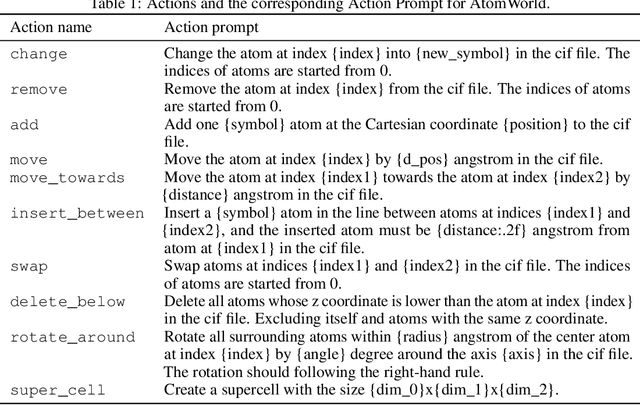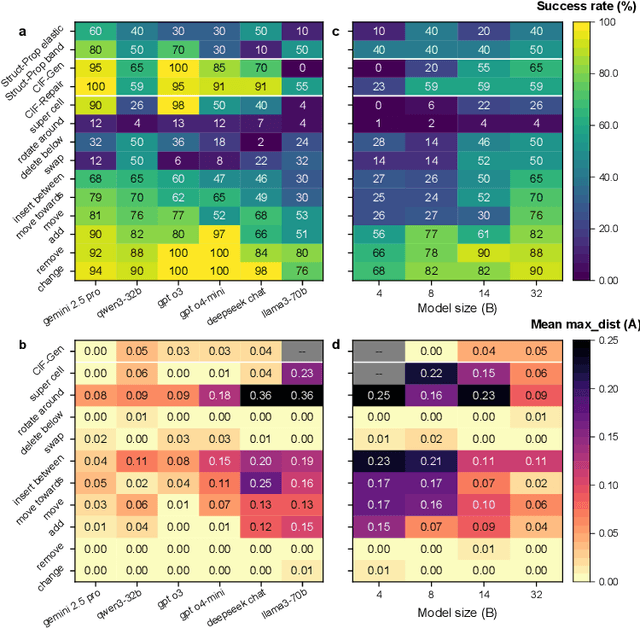Zhicheng Zhong
AtomWorld: A Benchmark for Evaluating Spatial Reasoning in Large Language Models on Crystalline Materials
Oct 06, 2025



Abstract:Large Language Models (LLMs) excel at textual reasoning and are beginning to develop spatial understanding, prompting the question of whether these abilities can be combined for complex, domain-specific tasks. This question is essential in fields like materials science, where deep understanding of 3D atomic structures is fundamental. While initial studies have successfully applied LLMs to tasks involving pure crystal generation or coordinate understandings, a standardized benchmark to systematically evaluate their core reasoning abilities across diverse atomic structures has been notably absent. To address this gap, we introduce the AtomWorld benchmark to evaluate LLMs on tasks based in Crystallographic Information Files (CIFs), a standard structure representation format. These tasks, including structural editing, CIF perception, and property-guided modeling, reveal a critical limitation: current models, despite establishing promising baselines, consistently fail in structural understanding and spatial reasoning. Our experiments show that these models make frequent errors on structure modification tasks, and even in the basic CIF format understandings, potentially leading to cumulative errors in subsequent analysis and materials insights. By defining these standardized tasks, AtomWorld lays the ground for advancing LLMs toward robust atomic-scale modeling, crucial for accelerating materials research and automating scientific workflows.
PointVoxel: A Simple and Effective Pipeline for Multi-View Multi-Modal 3D Human Pose Estimation
Dec 12, 2023



Abstract:Recently, several methods have been proposed to estimate 3D human pose from multi-view images and achieved impressive performance on public datasets collected in relatively easy scenarios. However, there are limited approaches for extracting 3D human skeletons from multimodal inputs (e.g., RGB and pointcloud) that can enhance the accuracy of predicting 3D poses in challenging situations. We fill this gap by introducing a pipeline called PointVoxel that fuses multi-view RGB and pointcloud inputs to obtain 3D human poses. We demonstrate that volumetric representation is an effective architecture for integrating these different modalities. Moreover, in order to overcome the challenges of annotating 3D human pose labels in difficult scenarios, we develop a synthetic dataset generator for pretraining and design an unsupervised domain adaptation strategy so that we can obtain a well-trained 3D human pose estimator without using any manual annotations. We evaluate our approach on four datasets (two public datasets, one synthetic dataset, and one challenging dataset named BasketBall collected by ourselves), showing promising results. The code and dataset will be released soon.
HumanReg: Self-supervised Non-rigid Registration of Human Point Cloud
Dec 09, 2023Abstract:In this paper, we present a novel registration framework, HumanReg, that learns a non-rigid transformation between two human point clouds end-to-end. We introduce body prior into the registration process to efficiently handle this type of point cloud. Unlike most exsisting supervised registration techniques that require expensive point-wise flow annotations, HumanReg can be trained in a self-supervised manner benefiting from a set of novel loss functions. To make our model better converge on real-world data, we also propose a pretraining strategy, and a synthetic dataset (HumanSyn4D) consists of dynamic, sparse human point clouds and their auto-generated ground truth annotations. Our experiments shows that HumanReg achieves state-of-the-art performance on CAPE-512 dataset and gains a qualitative result on another more challenging real-world dataset. Furthermore, our ablation studies demonstrate the effectiveness of our synthetic dataset and novel loss functions. Our code and synthetic dataset is available at https://github.com/chenyifanthu/HumanReg.
 Add to Chrome
Add to Chrome Add to Firefox
Add to Firefox Add to Edge
Add to Edge